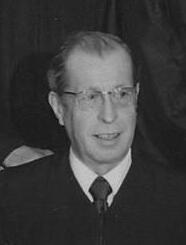
The Supreme Court of the United States is the highest-ranking judicial body in the United States. Established by Article III of the Constitution, the detailed structure of the court was laid down by the 1st United States Congress in 1789. Congress specified the Court's original and appellate jurisdiction, created 13 judicial districts, and fixed the initial size of the Supreme Court. The number of justices on the Supreme Court changed six times before settling at the present total of nine in 1869. As of June 2022, a total of 116 justices have served on the Supreme Court since 1789. Justices have life tenure, and so they serve until they die in office, resign or retire, or are impeached and removed from office.

Clement Furman Haynsworth Jr. was a United States circuit judge of the United States Court of Appeals for the Fourth Circuit. He was also an unsuccessful nominee for the United States Supreme Court in 1969.
During President Bill Clinton's first and second terms of office, he nominated 24 people for 20 federal appellate judgeships but the nominees were not processed by the Republican-controlled Senate Judiciary Committee. Three of the nominees who were not processed were nominated after July 1, 2000, the traditional start date of the unofficial Thurmond Rule during a presidential election year. Democrats claim that Senate Republicans of the 106th Congress purposely tried to keep open particular judgeships as a political maneuver to allow a future Republican president to fill them. Of the 20 seats in question, four were eventually filled with different Clinton nominees, fourteen were later filled with Republican nominees by President George W. Bush and two continued to stay open during Bush's presidency. Senator Harry Reid, the Democratic leader of the United States Senate during the 110th Congress, and Senator Patrick Leahy, the Democratic leader of the Senate Judiciary Committee under Reid, repeatedly mentioned the controversy over President Clinton's court of appeals nominees during the controversy involving the confirmation of Republican court of appeals nominees during the last two years of Bush's second term. Republicans claimed that Democrats were refusing to confirm certain longstanding Bush nominees in order to allow a future Democratic president in 2009 to fill those judgeships.
During President Jimmy Carter's presidency, he nominated four people for four different federal appellate judgeships who were not processed by the Democratic-controlled Senate Judiciary Committee before Carter's presidency ended. None of the four nominees were renominated by Carter's successor, President Ronald Reagan. Three of the nominees who were not processed were nominated after July 1, 1980, the traditional start date of the unofficial Thurmond rule during a presidential election year. All four seats eventually were filled by appointees of President Ronald Reagan.
During President Ronald Reagan's presidency, he nominated two people for the Supreme Court and at least twelve people for various federal appellate judgeships who were not confirmed. In some cases, the nominations were not processed by the Democratic-controlled Senate Judiciary Committee before Reagan's presidency ended, while in other cases, nominees were rejected by the Senate Judiciary Committee or even blocked by unfriendly members of the Republican Party. Three of the nominees were renominated by Reagan's successor, President George H. W. Bush. Two of the nominees, Ferdinand Francis Fernandez and Guy G. Hurlbutt, were nominated after July 1, 1988, the traditional start date of the unofficial Thurmond Rule during a presidential election year. Eight of the thirteen seats eventually were filled by appointees of President George H. W. Bush.
Harry Walker Wellford was a United States circuit judge of the United States Court of Appeals for the Sixth Circuit and a United States district judge of the United States District Court for the Western District of Tennessee.
During President Gerald Ford's presidency, he nominated two people for two different federal appellate judgeships who were not processed by the Democratic-controlled Senate Judiciary Committee before Ford's presidency ended. Neither of the two nominees was renominated by Ford's successor, President Jimmy Carter. Both nominees were nominated after July 1, 1976, the traditional start date of the unofficial Thurmond Rule during a presidential election year. Both seats eventually were filled by appointees of President Jimmy Carter.
During President Richard Nixon's presidency, federal judicial appointments played a central role. Nixon appointed four individuals to the Supreme Court of the United States in just over five and a half years.
President Richard Nixon entered office in 1969 with Chief Justice Earl Warren having announced his retirement from the Supreme Court of the United States the previous year. Nixon appointed Warren E. Burger to replace Earl Warren, and during his time in office appointed three other members of the Supreme Court: Associate Justices Harry Blackmun, Lewis F. Powell, and William Rehnquist. Nixon also nominated Clement Haynsworth and G. Harrold Carswell for the vacancy that was ultimately filled by Blackmun, but the nominations were rejected by the United States Senate. Nixon's failed Supreme Court nominations were the first since Herbert Hoover's nomination of John J. Parker was rejected by the Senate.
The nominations made by Lyndon B. Johnson to the Supreme Court of the United States are unusual in that Johnson appeared to have had specific individuals in mind for his appointments and actively sought to engineer vacancies on the Court to place those individuals on the court.



